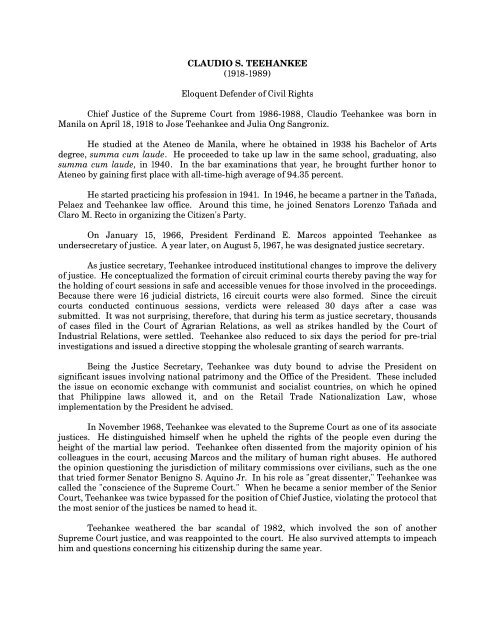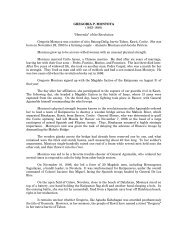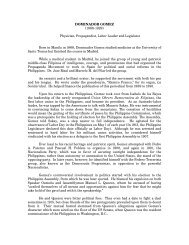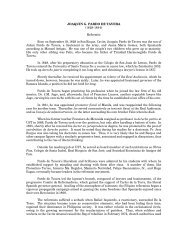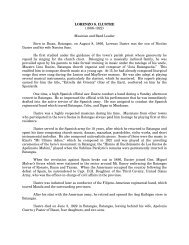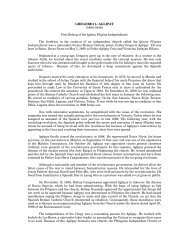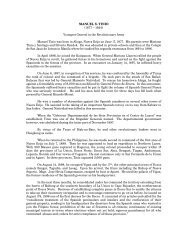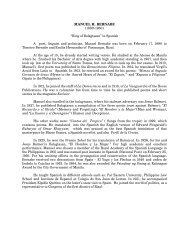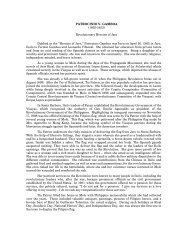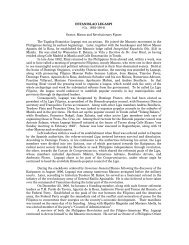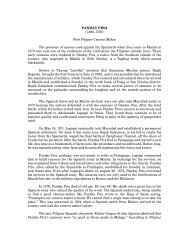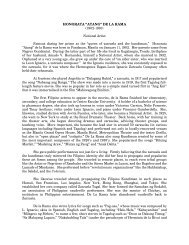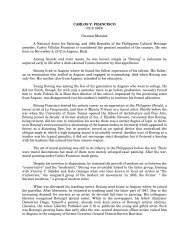CLAUDIO S. TEEHANKEE (1918-1989) Eloquent Defender of Civil ...
CLAUDIO S. TEEHANKEE (1918-1989) Eloquent Defender of Civil ...
CLAUDIO S. TEEHANKEE (1918-1989) Eloquent Defender of Civil ...
Create successful ePaper yourself
Turn your PDF publications into a flip-book with our unique Google optimized e-Paper software.
<strong>CLAUDIO</strong> S. <strong>TEEHANKEE</strong><br />
(<strong>1918</strong>-<strong>1989</strong>)<br />
<strong>Eloquent</strong> <strong>Defender</strong> <strong>of</strong> <strong>Civil</strong> Rights<br />
Chief Justice <strong>of</strong> the Supreme Court from 1986-1988, Claudio Teehankee was born in<br />
Manila on April 18, <strong>1918</strong> to Jose Teehankee and Julia Ong Sangroniz.<br />
He studied at the Ateneo de Manila, where he obtained in 1938 his Bachelor <strong>of</strong> Arts<br />
degree, summa cum laude. He proceeded to take up law in the same school, graduating, also<br />
summa cum laude, in 1940. In the bar examinations that year, he brought further honor to<br />
Ateneo by gaining first place with all-time-high average <strong>of</strong> 94.35 percent.<br />
He started practicing his pr<strong>of</strong>ession in 1941. In 1946, he became a partner in the Tañada,<br />
Pelaez and Teehankee law <strong>of</strong>fice. Around this time, he joined Senators Lorenzo Tañada and<br />
Claro M. Recto in organizing the Citizen's Party.<br />
On January 15, 1966, President Ferdinand E. Marcos appointed Teehankee as<br />
undersecretary <strong>of</strong> justice. A year later, on August 5, 1967, he was designated justice secretary.<br />
As justice secretary, Teehankee introduced institutional changes to improve the delivery<br />
<strong>of</strong> justice. He conceptualized the formation <strong>of</strong> circuit criminal courts thereby paving the way for<br />
the holding <strong>of</strong> court sessions in safe and accessible venues for those involved in the proceedings.<br />
Because there were 16 judicial districts, 16 circuit courts were also formed. Since the circuit<br />
courts conducted continuous sessions, verdicts were released 30 days after a case was<br />
submitted. It was not surprising, therefore, that during his term as justice secretary, thousands<br />
<strong>of</strong> cases filed in the Court <strong>of</strong> Agrarian Relations, as well as strikes handled by the Court <strong>of</strong><br />
Industrial Relations, were settled. Teehankee also reduced to six days the period for pre-trial<br />
investigations and issued a directive stopping the wholesale granting <strong>of</strong> search warrants.<br />
Being the Justice Secretary, Teehankee was duty bound to advise the President on<br />
significant issues involving national patrimony and the Office <strong>of</strong> the President. These included<br />
the issue on economic exchange with communist and socialist countries, on which he opined<br />
that Philippine laws allowed it, and on the Retail Trade Nationalization Law, whose<br />
implementation by the President he advised.<br />
In November 1968, Teehankee was elevated to the Supreme Court as one <strong>of</strong> its associate<br />
justices. He distinguished himself when he upheld the rights <strong>of</strong> the people even during the<br />
height <strong>of</strong> the martial law period. Teehankee <strong>of</strong>ten dissented from the majority opinion <strong>of</strong> his<br />
colleagues in the court, accusing Marcos and the military <strong>of</strong> human right abuses. He authored<br />
the opinion questioning the jurisdiction <strong>of</strong> military commissions over civilians, such as the one<br />
that tried former Senator Benigno S. Aquino Jr. In his role as "great dissenter," Teehankee was<br />
called the "conscience <strong>of</strong> the Supreme Court." When he became a senior member <strong>of</strong> the Senior<br />
Court, Teehankee was twice bypassed for the position <strong>of</strong> Chief Justice, violating the protocol that<br />
the most senior <strong>of</strong> the justices be named to head it.<br />
Teehankee weathered the bar scandal <strong>of</strong> 1982, which involved the son <strong>of</strong> another<br />
Supreme Court justice, and was reappointed to the court. He also survived attempts to impeach<br />
him and questions concerning his citizenship during the same year.
At the height <strong>of</strong> the EDSA Revolution in February 1986, Teehankee played a crucial role<br />
in swearing in Corazon C. Aquino as the country's 11 th President while Marcos was holding his<br />
own inaugural ceremony at Malacañang.<br />
Teehankee served as Chief Justice until his retirement on April 18, 1988. He died <strong>of</strong><br />
cancer in New York on November 27, <strong>1989</strong> at the age <strong>of</strong> 72.<br />
References:<br />
Fernan, Marcelo B. “A Tribute to Dingdong Teehankee” Manila Bulletin (December 17,<br />
<strong>1989</strong>)<br />
Retizos, Isidro L. & Soriano, D.H. Philippines Who’s Who. Quezon City: Capitol Publishing<br />
House, Inc., 1981.<br />
Sevilla, Victor J. Justices <strong>of</strong> the Supreme Court <strong>of</strong> the Philippines Volume III Quezon City: the<br />
Author & New Day Publishers, 1985<br />
Photo in: Justices <strong>of</strong> the Supreme Court <strong>of</strong> the Philippines, p. 42


